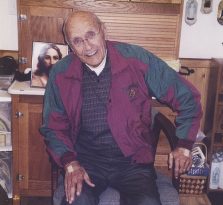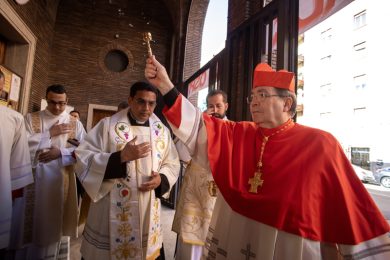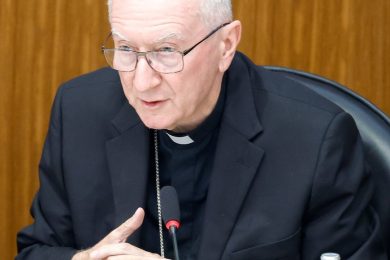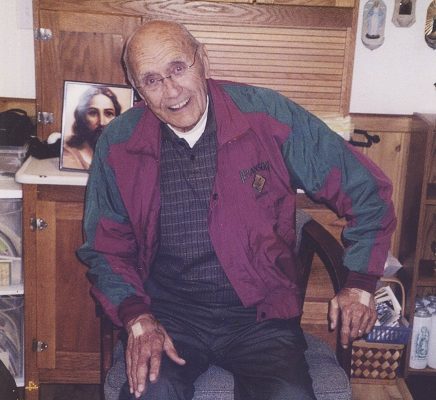By Joseph O’Brien | OSV News
Irving “Francis” Houle’s death in 2009 didn’t make national news. He wasn’t what the world would consider either a mover or a shaker.
But his death touched many in the Michigan Upper Peninsula Diocese of Marquette and around the country, who knew Houle through his prayer ministry and as a healer of bodies and souls.

By all accounts, Houle led a relatively normal life. He was survived by his wife of 61 years, Gail Houle, and their five children, seven grandchildren and four great-grandchildren. He was raised on a rural farm in upper Michigan, graduated from a Catholic high school and served in the Army during World War II with an honorable discharge in 1946. He was a factory worker and a Knight of Columbus.
And he also apparently had the stigmata.
Could Houle have a place among the great stigmatist saints of the church’s history — including Catherine of Siena, Francis of Assisi, Rita of Cascia and Padre Pio of Pietrelcina?
Catholics may find out soon enough. In November 2018, Bishop John Doerfler of Marquette, Michigan opened the cause of canonization for Servant of God Irving C. Houle. In June 2019, the U.S. Catholic bishops indicated their support for the advancement of the cause at their Plenary Assembly in Baltimore.
Irving Houle had prayed for, and apparently received throughout the last 16 years of his life, the privilege to share in Christ’s sufferings as a disciple in a particularly unique way.
As taught by the Second Vatican Council, the Catholic Church teaches that Jesus Christ is “the one Mediator and the unique way of salvation,” with followers of Jesus being united to his sufferings as members of his body, “suffering with Him, that with Him we may be glorified.”
St. John Paul II, in his 1984 letter “Salvifici Doloris,” explained that “each man, in his suffering, can also become a sharer in the redemptive suffering of Christ” and that this realization caused St. Paul to tell the Galatians, “I have been crucified with Christ, it is no longer I who live, but Christ who lives in me: and the life I now live in the flesh I live by faith in the Son of God, who loved me and gave himself for me.”
However, some followers of Christ have manifested this profound truth of the Christian life in their own bodies in a mystical way, through the stigmata. Sometimes described as “victim souls,” these people intend that Jesus transform their sufferings into grace for others in most need of God’s love.
Houle may be one such person.
Father Robert J. Fox, founder and former director of the Alabama-based Fatima Family Apostolate International, probably knew as much about Houle’s life as anyone. He’d written a book about his life titled “A Man Called Francis,” and he had come to know Houle well since they first met in 1992.
“Irving would go into ecstasies between midnight and 3 a.m.,” Father Fox said prior to his death in 2009. “After Good Friday 1993, when he received the stigmata, his wounds would bleed every Holy Thursday night into Good Friday. All during Lent, every Lent, there was extra suffering. He also had visions of Christ and locutions, although these only in the first years of his ministry.”
Locutions are a form of private revelation. Unlike apparitions, which are seen, locutions are spiritual messages communicated interiorly, through a person’s hearing, imagination or intellect.
In fact, it was the Virgin Mary’s locutions, Father Fox said, which defined Houle’s mission to souls.
“You said ‘yes’ to my good Jesus,” Our Lady allegedly told Houle in an Oct. 2, 1995, locution, which Father Fox printed in his book on Houle. “All hurts, persecution, betrayals and pain is the Passion. You will continue to suffer. This is all for conversions; many, many will be saved.”
After confirming that his prayers to suffer like Jesus Christ had been answered, the message reveals the exact nature of his ministry.
“Continue to touch my children whom you are led to and to whom I lead you,” the message reads. “Continue to pray for those who have gone astray.”
Ordained a deacon in 2010, Terry Saunders was a police detective with the Michigan State Police from 1987 until his retirement in 1993. Covering everything from murders to burglaries and sex crimes, Saunders also served on the State Police SWAT team, taking part in hostage situations and other high-pressure crime scenarios.
As a close friend and member of Houle’s prayer group, Saunders witnessed enough healings to fill up “three notebooks,” he said. But it was Saunders’ own healing, after being diagnosed with lung cancer in 1992, that had the most profound effect on him.
“Every time Irving would see me, he would greet me and put his arm around me and his hand on my chest,” he said. “Every time he did that, bolts of white heat would course through my chest. I could feel it immediately.”
Not long after his failing health forced him to stop chemotherapy, Saunders attempted a last-ditch effort at removing the cancer through surgery. After the procedure, his doctor informed him of a remarkable discovery — the cancer was completely gone.
“I asked him how he could explain that, and he said he couldn’t,” Deacon Saunders said.
Looking back, Saunders realized that his healing had begun soon after Houle received his wounds in 1993.
“He looked haggard that day, and I said to him, ‘Irving, what happened to you?'” he said, noting that Houle held up his hands to show the wounds and in a calm voice said, “I don’t know what’s happening to me.”
At that point, Saunders fell over involuntarily on his side.
“My very first thought was, ‘Thank you, Jesus, for showing that you died for me on the cross and that no matter what happens to me, I’m going to be OK.'”
As the most conspicuous sign of Houle’s own mystical manifestation of the redemptive suffering of Christ, his hands were used to heal — but had themselves a constant reminder of Christ’s eternal wounds.
According to Father Fox, Houle first detected pain in his hands Holy Thursday evening at the Mass of the Lord’s Supper.
“In the morning, he woke up and here were these big marks on the palms on his hands,” the priest said. “The tops of his hands were different too. He never showed the tops to anyone and he never called himself a stigmatist.”
In 1997, Father Fox asked Dr. David Wachs, a family practice physician from South Dakota, to examine Houle’s wounds. In summarizing his findings, Wachs noted that Houle’s circulation was “excellent,” and there was no evidence of “self-mutilation” or infection.
“I cannot understand medically why these wounds would not heal or open up at different times,” Wachs concluded in his letter to Father Fox. “I am not able to explain the source of his pain.”
In an interview with Our Sunday Visitor, Wachs said he stands by the results of the 1997 examination and remembers it well.
“I remember that examination, absolutely,” he said. “It’s the kind of thing you only see once in your life.”
Certain features of the wounds, Wachs said, indicated that this was not a natural occurrence.
“If you look at the symmetry of the wound in the wrist area, for instance,” he said, “it’s very difficult to self-inflict a wound like that.”
Also of interest, Wachs added, was the fact that the wounds neither healed nor seemed to become infected.
“They didn’t seem to change or show up anywhere else on his body either, like other sores might,” he said. “They would continue to ooze blood, too.”
Wachs, who joined the Catholic Church before meeting Houle, said he would willingly stake his entire medical career on the claim that these wounds had no natural medical explanation.
“And if the church ever needed a person to testify about these wounds, I would gladly do it,” he said.
Archbishop Alexander K. Sample of Portland, Oregon, served as bishop of Marquette from 2006 to 2013, and had followed his predecessor, Bishop James H. Garland, in granting Houle approval to continue his work of healing among the faithful. A native of the Marquette diocese, Archbishop Sample said he first met Houle while serving the diocese as a priest.
He said he doesn’t remember much about their first conversation, but like many people — including Saunders and Father Fox — he experienced something about him he would never forget.
“I remember distinctly the aroma of roses about him,” he said.
Archbishop Sample’s second meeting with Houle took place shortly after he was ordained bishop of Marquette. He said he was impressed by Houle’s desire to seek his bishop’s blessing of his ministry.
“He was respectful that way, and wanted to be in communion with his bishop,” he said. “He wanted to make sure his bishop approved of what he was doing.”
“He didn’t draw attention to himself,” Archbishop Sample said. “He gave the glory to God and not to himself. That was a confirmation for me that he was authentic.”
As for the stigmata, the archbishop said neither he nor Bishop Garland sought official confirmation of the wounds, satisfied that the man himself was blessing enough for the Diocese of Marquette.
“He clearly touched the lives of many people,” Archbishop Sample said. “He helped many people, and that certainly was a blessing to the church and to our diocese.”
“I think Irving would be the first to say he wouldn’t want any further attention drawn to himself,” he said. “He wasn’t the kind of guy that wanted some sort of official spectacular recognition as a stigmatist or extraordinary person of healing prayer.”
– – –
Joseph O’Brien writes from Soldiers Grove, Wisconsin.






















